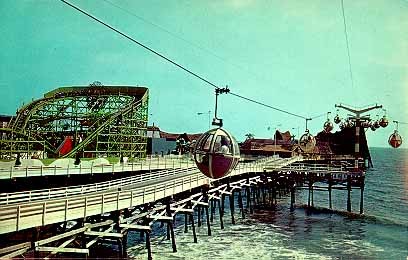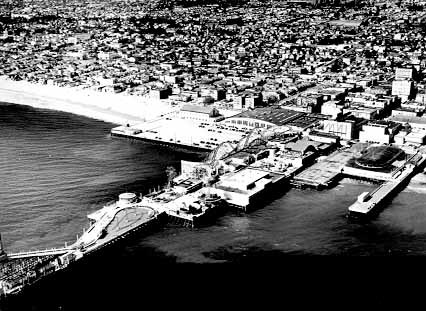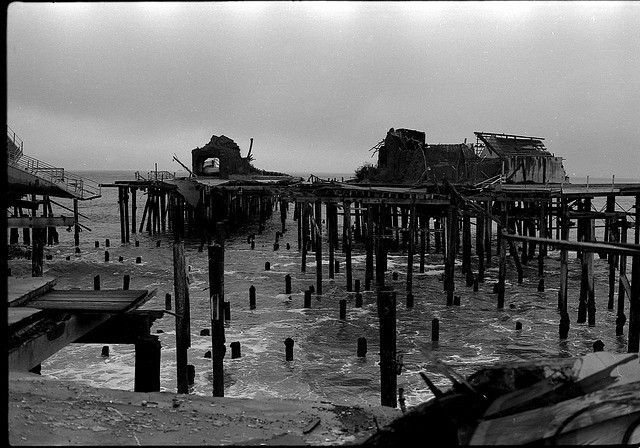Pacific Ocean Park Pier
Introduction
Text-to-speech Audio
Images
Pacific Ocean Park Pier in 1959 when the amusement park was in full motion. Photograph by Jeffery Stanton, "Pacific Ocean Park" ca. 1959. http://www.westland.net/venicehistory/articles/pop.htm

Ariel view of Pacific Ocean Park. Photograph found at http://pacificoceanpark.tripod.com/ "Ocean Park Pier" ca. 1946

Pacific Ocean Park Pier after its closer in 1967. Photograph found at http://www.keyword-suggestions.com/cGFjaWZpYyBvY2VhbiBwYXJr/ "The Rise and Spectacular Fall of Pacific Ocean Park"

Backstory and Context
Text-to-speech Audio
After the pier closed in 1967 it became forgotten along with the surrounding area. A place that was once a paradise on the sea became a rotting, abandon pier of trash that was decaying in the water. This place became a place for teens to go cause trouble and explore the decaying pier. It became a place for drug addicts to get high and place for pyromaniacs to set fire. 4 While the Pacific Ocean Park Pier had been forgotten and left to rot the surrounding Santa Monica area did too. This area became a place filled with crime, poverty, and urban decay. This area of Santa Monica became known as Dogtown and was considered one of the last seaside slums of America. 5 This Pier became the ultimate symbol for Dogtown as it lay rotting in the sea forgotten by everyone.
While the pier was became a new home for drug addicts, and people to cause trouble it also became home to another group of people. This group of people were the surfers of Dogtown. These surfers took to surfing under the pier because of the type of wave created there. Surfing here was extremely dangerous due to the piers debris that tainted the surrounding area. In order to ride here one had to be skilled and not afraid to get hurt, which heavily influenced the hardcore style of riding that the surfers of Dogtown were known for. This pier became an infamous surf spot that many people wanted to come surf. Although, unlike the amusement park that was once on the pier, non-locals were not welcome. Local riders did everything they could to protect their surf spot from outsiders. They would do everything from throwing rocks at non-locals to destroying their car engines. 6 The surfers of Dogtown would go on to be part of a surf and skate team for the company Zephyr. This team would become known as the Z-boys who would later go on to revolutionize skateboarding. While this pier was abandon and the original idea of an amusement park was forgotten, it did become famously known as the heart of Dogtown and home for the Z-boys.
Cite This Entry
Saint Michael's College. "Pacific Ocean Park Pier." Clio: Your Guide to History. November 10, 2016. Accessed April 25, 2025. https://theclio.com/tour/2521/6
Sources
2 Miranda, Carolina A. "The Rise and Spectacular Fall of Venice Beach's Pacific Ocean Park." Los Angeles Times. Accessed November 10, 2016. http://www.latimes.com/entertainment/arts/miranda/la-et-cam-venice-beach-new-book-rise-and-fall-paci....
3 Miranda, Carolina A. "The Rise and Spectacular Fall of Venice Beach's Pacific Ocean Park." Los Angeles Times. Accessed November 10, 2016. http://www.latimes.com/entertainment/arts/miranda/la-et-cam-venice-beach-new-book-rise-and-fall-paci....
4 Dogtown and Z-boys. Directed by Stacy Peralta. Performed by Jay Adams, Tony Alva, Sean Penn. United States of America: Agi Orsi Productions, 2001. DVD. Info also cited from: Duggan, T. (2016). Dogtown. Unpublished, Manuscript. St. Micheal's College.
5 Ibid
6 Ibid

